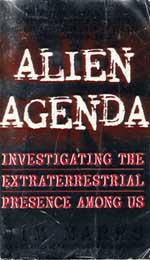 Aliens are among us –- so states Jim Marrs. So what are they up to?
Aliens are among us –- so states Jim Marrs. So what are they up to?If you’re looking for a solid answer, you’ll be disappointed after reading Alien Agenda: Investigating the Extraterrestrial Presence Among Us (1997). Marrs is described as an “award-winning journalist” on the back cover. I don’t know if he won a Pulitzer, but I’ll say one thing for him: he can write a ripping good anecdote.
His book is loaded with evidence –- of the anecdotal kind. He covers major incidents in UFO history, contending that The Powers That Be In The Shadows are hiding the truth from us. At times –- probably because of his journalistic background – Marrs will present some wild explanation and then back off a bit with a qualifying statement something like “No one can really say if this theory is correct, but it could provide an answer.”
Or a bit of far out speculation is followed by a qualifying statement intended to lead the reader to draw a specific conclusion. For example, at one point Marrs is talking about strange sightings of what some purport to be intelligently constructed buildings on the lunar surface. On pages 23-24 he states (emphasis added): “If these structures are pyramids and if they do match the layout of the Egyptian pyramids, they might connect to the pyramid-shaped structures photographed by a Viking probe of Mars in 1976.”
With that last statement, an uncritical or inattentive reader would think Marrs made this statement: “There are Egyptian pyramids on the moon, just like the ones on Mars, made by aliens.” But he didn’t say that –- thanks to the use of key qualifiers “if” and “might.”
On the topic of ancient astronauts, i.e. aliens who visited mankind in the past, Marrs asks this question (page 61): “Does any tangible proof exist today to support the idea of high technology in the distant past?”
His conclusion (emphasis added): “The answer would seem to be a clear ‘yes’ after considering some of the world’s known mysteries.” A clear “yes” precludes any qualifying phrases such as “would seem to be.” If the answer is clearly true, it’s apparent, no conditions attached.
With his use of qualifiers, Marrs suffers from “seemyness” at certain points in his book. Obviously, as a writer, he’s over-qualified.


Comments